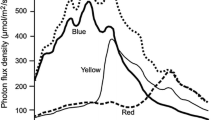Abstract
The visual ecology of six closely related species of Puerto Rican anoline lizards was investigated and they were found to occupy four distinct habitat types in terms of light conditions: “full shade”, “partial shade”, “no shade”, and “forest canopy.”The habitats differed substantially in total radiance and irradiance as well as in the shape of the irradiance spectrum. The shape of the radiance spectrum was similar in all of the habitats. We used electroretinogram (ERG) flicker photometry to measure spectral sensitivity and found the curves for all six species to be similar. The spectral sensitivity peaked in the range 550–560 nm, which matched the peak in spectral radiance for all of the habitats. The shape of the spectral-sensitivity curve was similar to those of a number of other terrestrial vertebrates. We suggest that the convergence of the shape of the photopic ERG-determined spectral-sensitivity curve in many terrestrial vertebrates may, in part, be due to the fact that the background radiance of many terrestrial habitats is dominated by the reflectance spectrum of green vegetation which peaks at 550 nm.
Similar content being viewed by others
Author information
Authors and Affiliations
Additional information
Accepted: 14 May 1997
Rights and permissions
About this article
Cite this article
Fleishman, L., Bowman, M., Saunders, D. et al. The visual ecology of Puerto Rican anoline lizards: habitat light and spectral sensitivity. J Comp Physiol A 181, 446–460 (1997). https://doi.org/10.1007/s003590050128
Issue Date:
DOI: https://doi.org/10.1007/s003590050128




